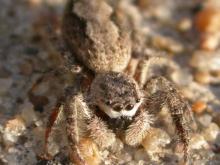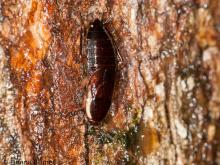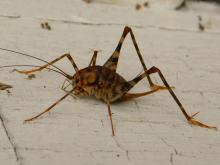Land Invertebrates
Media

Species Types
Scientific Name
Rabidosa punctulata
Description
The dotted wolf spider has a solid brown stripe running down the middle of the abdomen, seen from above. Like other wolf spiders, females have strong maternal instincts, carrying their spiderlings around on their back until they can be on their own.
Media

Species Types
Scientific Name
Rabidosa rabida
Description
The rabid wolf spider, despite its scary name, is harmless to people and is absolutely not rabid. It commonly hides in leaf litter and sometimes gets into houses.
Media

Species Types
Scientific Name
About 300 species globally
Description
True velvet mites: You’ve probably seen these small, velvety, bright red mites creeping around on rocks, plant containers, tree trunks, or on the ground, especially after a rain. Be not afraid! They are harmless — to people.
Media

Species Types
Scientific Name
Vespa crabro
Description
The European hornet is a large, nonnative hornet that was introduced to New York in the mid-1800s. They now occur across most of the eastern United States, including Missouri. People may misidentify them as the highly publicized, so-called murder hornets.
Media

Species Types
Scientific Name
Pachypsylla spp.
Description
Hackberry psyllids are a genus of tiny, planthopper-like bugs. As larvae, they develop within the leaves, twigs, buds, or bark of hackberry trees. The trees form warty galls in response to their presence. In the fall, tiny adult hackberry psyllids cling to window screens.
Media

Species Types
Scientific Name
Apis mellifera
Description
The honeybee is a major pollinator of many field crops and tree fruits. Native to the Old World, it is not native to North America. In 1985 it was named the official state insect of Missouri.
Media

Species Types
Scientific Name
Platycriptus undatus
Description
The tan jumping spider usually lives on tree trunks. Its gray, tan, and brown coloration camouflages it against tree bark. There is usually an undulating pattern on the abdomen.
Media

Species Types
Scientific Name
Over 100 species of cockroaches and termites in North America north of Mexico
Description
Cockroaches well-known: they are flattened, small, brown or black, often shiny insects that can hide in tight crevices and lack specialized appendages. Recently, termites have been included in their order.
Media

Species Types
Scientific Name
About 40 species in North America north of Mexico
Description
People often confuse termites with ants. Termites have a fairly cylindrical body, only slightly narrowed behind the head. Termites also have a pronotum, a shieldlike plate behind the head.
Media

Species Types
Scientific Name
About 150 species in North America north of Mexico
Description
Camel crickets and cave crickets are odd-looking, hump-backed insects that are commonly found in caves, basements, cellars, and similar places.
See Also



Media

Species Types
Scientific Name
Cisseps fulvicollis
Description
The yellow-collared scape moth is more often “orange-collared.” And whether you think it looks more like a firefly or a wasp, it’s still a moth!
Media

Species Types
Scientific Name
Nearly 150 species in North America north of Mexico
Description
Slim, delicate plume moths are instantly recognizable by their T-shaped silhouette, long legs, and muted shades of tan and brown. It can be hard to separate the various species.
Media

Species Types
Scientific Name
Pyrrharctia isabella
Description
Not many people know the adult Isabella tiger moth when they see one, but we’re all acquainted with its caterpillar, the woolly worm, or woolly bear.
About Land Invertebrates in Missouri
Invertebrates are animals without backbones, including earthworms, slugs, snails, and arthropods. Arthropods—invertebrates with “jointed legs” — are a group of invertebrates that includes crayfish, shrimp, millipedes, centipedes, mites, spiders, and insects. There may be as many as 10 million species of insects alive on earth today, and they probably constitute more than 90 percent all animal species.





















